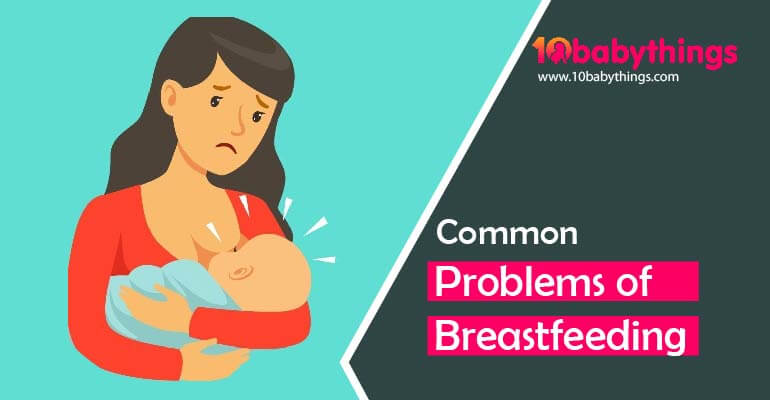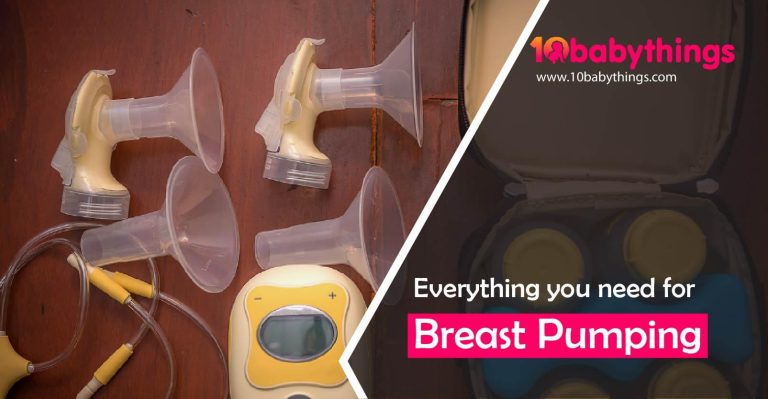Common Problems of Breastfeeding (and How to Solve Them)

Breastfeeding can go smoothly for some babies right from the start, but it isn’t always the case for others. The process of learning how to breastfeed together takes time for many moms and babies.
If you’re breastfeeding your new baby in the first week, you might run into some problems. Although breastfeeding can go smoothly once it’s established, issues can still happen. The pain and frustration of breastfeeding problems can cause a new mom to become frustrated, and a baby to become fussy.
Sometimes unexpected problems lead to early weaning because it can be scary to deal with them. But you can handle these common breastfeeding problems by learning about and understanding them. Here’s a list of some of the common breastfeeding problems and how to fix them as you go through the newborn stage to weaning.
Sore Nipples
During the first few weeks of breastfeeding, you may experience some tenderness around the nipples. There’s nothing wrong with that. Nipples that are very sore, cracked, and bleeding are not considered normal. Something isn’t right when they appear. The pain of breastfeeding is a big problem if your nipples are sore. If sore nipples do develop, be sure to continue breastfeeding and treat them as soon as possible. Obtain help from a lactation consultant or your doctor if you need it.
- Ensure your baby latches on properly.
- Whenever you are breastfeeding, try a different position and change positions every few minutes.
- Before removing the baby from the breast, gently break the suction from the latch.
- Feed your pet frequently and in short bursts.
- Breastfeed on your least sore breast first.
- Nipples should be treated with warm, moist compresses.
- You can help your nipples heal by applying freshly expressed breast milk.
- Your healthcare provider should be notified if your nipples do not improve within a few days. An infection can enter your body through any opening in the skin, which can make the situation worse.
Breast Engorgement
Breasts can become swollen and tight by the end of the first week when breast milk fills them. When your breasts are engorged, your newborn may find it difficult to latch on to your large, hard breasts. It usually takes a few days or weeks for your milk supply to adjust to your baby’s needs during this initial phase of engorgement. You should focus on relieving the pressure and pain while your body adjusts.
- A newborn should be breastfed at least eight to twelve times a day.
- When your child latches on properly and is positioned correctly, she will be able to remove more milk from her breasts.
- You can relieve pain and pressure by using a breast pump or hand-expression technique if your child isn’t breastfeeding well or you still feel full after breastfeeding.
- To make breastfeeding easier for your baby, remove a little breast milk before you begin. By removing breast milk, you can also relieve some pressure, so your baby will not experience too much force when milk flows out of her breasts.
- To relieve pain, alternate cold and warm compresses. Cold cabbage leaves can also be used instead of a cold compress.
- The breasts should be gently massaged.
- In the shower, lather up your breasts with warm water.
Milk ducts plugged
There are small, hard lumps in the breast associated with plugged milk ducts. The narrow milk ducts become blocked when breast milk clogs up. There may be tenderness, swelling, and redness around the plugged duct. Within a few days, plugged milk ducts usually disappear on their own. Take these steps to help it along.
- You should ensure that your baby latches on correctly and that your breasts are removing breast milk efficiently.
- To prevent clogs in your milk ducts, breastfeed frequently.
- If the duct is plugged, breastfeed on that side first. Unblocking the duct may be made easier by your baby’s strong suck at the beginning of each feeding.
- Ensure that your breasts are properly drained by changing breastfeeding positions. It may be possible to dislodge the blocked duct using different holds depending on where it is located on your breast.
- In order to encourage better milk flow, apply warm compresses to the plug.
- You can relieve the plug in your breast by massaging it while you are breastfeeding.
- Stay hydrated and get enough rest.
A lump that doesn’t disappear or that grows should be reported to your doctor.
Mastitis
An infection of the breast is called mastitis if the breast tissue is swollen or inflamed. Mastitis can also be caused by breast enlargement, blocked milk ducts, fatigue, or illness. Fever, redness, and tenderness of the breast are signs of mastitis.
- Your doctor should be consulted if you suspect mastitis. Infections may require antibiotics.
- With mastitis, you don’t have to stop breastfeeding, but you should continue.
- While you are recovering, make sure you get plenty of rest
- Help ease pain by applying warm compresses
Thrush
An infection of the nipples or the mouth of the baby is called thrush. In addition to breast pain, thrush may cause redness, itching, or a rash on the nipples. Your baby’s mouth may also appear white or red.
- Your doctor should be notified as soon as possible if you or your child have thrush. You and your baby may need antifungal medication.
- Make sure all pacifiers, bottles, toys, and parts of your breast pump are cleaned and sterilized before use.
- To prevent the spread of infection, it is very important to wash your hands properly.
A Low Breast Milk Supply
Fear and frustration can accompany a low breast milk supply. A new mom may feel scared that she’s not producing enough breast milk for her child, and a baby may feel frustrated if she isn’t receiving enough. Low breast milk supply can often be fixed by correcting the common causes.
- Make sure your baby is latching well. Breastfeeding effectively requires your newborn to take in your entire nipple and some surrounding breast tissue. The amount of breast milk your child removes from your breasts will determine how much milk your body produces.
- Increase the amount of time you breastfeed your baby. Throughout the day, your newborn needs to be breastfed every 1 to 3 hours. You will produce more breast milk the more you breastfeed.
- Continue to breastfeed your baby for a longer period of time. During each feeding, try to keep your baby awake and actively sucking for at least 10 minutes.
- After and between feedings, use a breast pump. You can increase your milk supply with extra stimulation at the breast.
- Take care of yourself by eating well, getting enough rest, and drinking plenty of water.
Breast milk in excess
It can be challenging to handle an abundance of breast milk. Breast engorgement plugged milk ducts, and mastitis can be caused by it. Breast milk can also flow out of your breasts faster if you have too much milk in your breasts. It can cause your baby to lose his appetite and be gassy, fussy, and spit up if he has a fast flow of milk during breastfeeding.
- When the baby wants to breastfeed again within an hour, offer the same breast as the previous feeding.
- It is also possible to breastfeed while lying down or reclining in a chair. The flow of milk may be slowed down by breastfeeding against gravity.
- Your baby should be burped frequently. As your baby gulps down fast-flowing milk, he may swallow more air.
Help When You Need It
It usually takes only a few days for breastfeeding-related complaints to go away. Consult your doctor or lactation consultant if any of these issues persist or worsen. You and your baby will benefit from identifying and correcting problems as early as possible.






